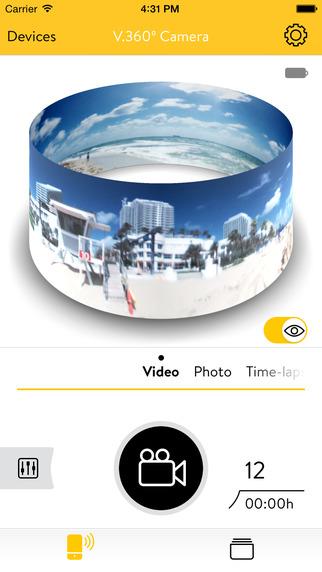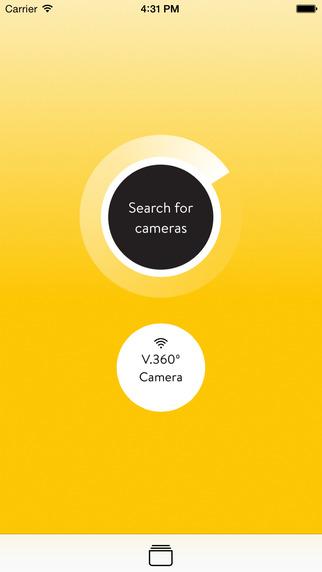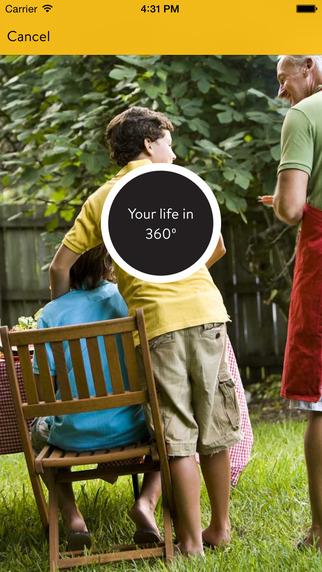“The V.360 360-degree camera is fun to use for a while, but it suffers from several first-generation issues, including subpar video quality.”
- Easy, fun to use
- 360-degree videos and photos
- Processing done in-camera
- Works with standard tripods and GoPro mounts
- Video, photo quality could be improved
- Lag, long wait-times using mobile app
- Pricey, early-adopter territory
- Panoramas aren’t fully spherical
In 2014, we heard a lot about 360-degree cameras in the works, but saw very few of them in action. We were told that these cameras would be the next big thing in photography and videography, but we’ve yet to feel the buzz. The V.360, from a Florida-based company called VSN Mobil, aims to change that by being one of the first you can buy. With a single camera and lens, the V.360 is able to capture a full 360-degree video or photo. You don’t have to choose what in the frame to shoot, because it’s capturing everything within its field of view.
But being the first has its downsides. VSN Mobile is introducing a product in a category that’s still in its infancy. Despite the tech that’s inside, the V.360’s photo and video quality is less than subpar, among other first-gen issues. Is it fun to use? Sure, but beyond the initial ghee-whiz experience of seeing a 360-degree view, do people have much use for this type of content?
Design and features
We aren’t sure how to describe the V.360 other than it looks somewhat like a mini spice grinder. A cylindrical aluminum bottom houses the 2,610mAh battery, MicroSD card slot (up to 128GB of Class 10, UHS-1, or higher), Micro USB 3.0 port, and tripod mount, covered by a water-tight cap that’s very difficult to close and open (but that’s the point). There’s also a Micro HDMI port, but there’s no use for it; we plugged it into a standard HDTV, but the TV said the feed isn’t supported. Inside is a 2.3GHz Qualcomm Snapdragon 800 quad-core processor that’s commonly found in many mid-range smartphones, which gives you an idea of how much processing power is required to shoot, stitch, and encode those 360-degree videos and photos – something VSN touts as an advantage and differentiator over other 360-degree cameras.
The camera also uses Android 4.4 as an operating system, but that’s behind the scenes and not user accessible. It supports Bluetooth 3.0 and 4.0 and 802.11b/g/n Wi-Fi (2.4GHz and 5GHz), and there are sensors for GPS, barometer, altimeter, and accelerometer. Dual pinhole mics on the outside capture stereo sound.
The clear bowl-like top is where the 360-degree camera resides. Inside a hard plastic shell is a six-element glass lens and 16-megapixel 1/2.3-inch sensor. VSN says the inside is filled with argon to prevent condensation. Outside, at the top, you’ll find a bubble level to help you keep the camera upright.
While VSN may tout the camera’s rugged attributes, it feels delicate and expensive.
The V.360 is designed to be rugged and waterproof (down to only approximately 3 feet, for 30 minutes). In fact, VSN even markets the V.360 as a GoPro-like action cam – if GoPro cameras did 360 degrees. Besides accessories that use standard tripod mounts, the V.360 also supports GoPro mounts. Still, it feels delicate and expensive – not something we feel comfortable throwing inside a bag. We quickly noticed unintentional wear-and-tear scratches on our unit, and the pouch that comes with the camera isn’t enough to fully protect it.
The lens has a 360 x 60-degree field of view, with a constant f/3.0 aperture. While the camera can shoot a full 360-degree panorama around you, it’s not a completely spherical camera, which means the top and bottom will be missing. Video resolution is recorded at up to 6480 x 1080 pixels and up to 30 frames per second, while stills are shot at up to the same resolution. At that resolution, you could say it shoots 4K videos.
There are no buttons to press. Once you slip the battery in, the camera turns on and is it standby. You can use the included Bluetooth-based remote control to turn the camera on/off, take a photo, or start recording a video, or a smartphone (iOS or Android) to activate it. The V.360 can also be controlled via a mobile device in two ways: you can use a Bluetooth connection to discover it and choose the various shooting modes, as well as adjust settings, or you can connect to it via Wi-Fi and get a live-view of what you’re shooting and content playback.
The Wi-Fi mode requires you to use the V.360 as an access point, which you connect to directly from your device’s Wi-Fi settings; others can also log into the camera while it’s in Wi-Fi access point mode, but we found it can only support one connection at a time. With the app, you can also shoot burst, time-lapse, and surveillance (security cam, where it takes a photo when something moves into frame) modes.
What’s in the box
The camera comes with a remote control, microfiber pouch, lithium-ion battery, USB 3.0 cable and charger, silicone sleeve to protect the bottom of the camera, adhesive dash mount, GoPro mount adapter, and AAA batteries for the remote. VSN includes very basic quick-start guides for the camera and remote; there isn’t a full manual to download, but we found the support website and FAQs to be very helpful.
Warranty
VSN Mobile provides a one-year limited warranty. The company also has a risk-free 30-day money back guarantee.
Performance and use
We had the chance to play with both an older unit and a newer one. VSN says the new version shoots higher resolution images, so we kept that in consideration as we reviewed the content we shot. Otherwise, they were both identical in looks and operation. We tested the camera using an iPhone 5S, iPad Mini, and second-gen Moto X. The user interface and features of the apps are the same (with minor rearrangement of icons between the Android and iOS versions), but we found the iPad and Android experience more enjoyable.
When it comes to usage, the V.360 is relatively easy. Push in the battery, seal the cover tightly, and it’s ready to go. If you are using the basic functions of the included remote control, it’s automatically paired, but advanced functions require Wi-Fi pairing. Like all action cams without a display, you’re shooting blindly, but with a 360-degree field of view, you are getting a lot more in the shot.
Lag mars the experience. The app often lost connection with the camera and had to reestablish the link, forcing us to endure more wait times. The app lets you edit (in an interesting but confusing manner) and create sharable videos (either as a 16:9 flat image, or a 4:3 revolving “shotglass,” where you see the full 360-degree video in a halo view), but it needs to encode first, which, depending on the length of the video, could take a long time; we initially thought the app had stalled, but it was actually still encoding. Worse, after it’s encoded and you’ve edited the video, you have to re-encode it again should you decide to make more edits.
If you don’t care about finer adjustments or live view, it’s quicker and simpler to use the included remote. Anything else will require long wait times. We will add that it’s also a mixed bag: There were times during our testing where the app was robust, and the smartphone connection was strong. Perhaps it’s Wi-Fi traffic, but the experience wasn’t always consistent.
For our test, we left the camera in its default setting, which had the max resolution, auto white balance (you can pick tungsten, fluorescent, sunny day, etc.), normal filter (there are options like sepia, black and white, etc.). Since it’s capturing a 360-degree view, you don’t have to worry what’s in the frame, but you will have to keep it leveled unless you don’t mind footage that’s atilt. It doesn’t need to stay stationary either, as you can walk with it and create “moving” 360-degree videos, but the live view is slow to catch up. Being able to mount it on a helmet, head, or chest using GoPro mounts is great, but, unlike most action cams, the V.360 is slightly heavy.
The camera is fun to use, and seeing action shots in 360 degrees is cool, but the small sensor recorded videos with a lot of noise and pixel artifacts, even in well-lit environments. A portion of our video with the sun overhead was completely washed out, even when set to the sunny white balance mode. They are still usable, but disappoint. Low-light shots, naturally, had a lot of noise, and videos taken in a near-dark room looked like a smudged painting.
The DT Accessory PackUp your game and the get the most out of your gear with the following extras, hand-picked by our editors:Manfrotto PIXI Mini Tripod ($25)Give the V.360 a sturdier grip in your hand with this mini tripod. The pivoting head lets you easily adjust the position of the camera to give you proper leveling.GoPro Side Mount ($9)
The V.360 is compatible with GoPro mounts. With this side mount, you can attach it to your helmet or board, and create 360-degree action shots.
Nanuk 903 Case ($30)
Despite the rugged attributes, we find the V.360 fragile. When not in use, store it in a hard case like these colorful ones from Nanuk.
Want to share your videos on YouTube? You will need to encode the video, edit it, and save it as a MP4 movie.You can also connect the camera to your computer as a mass storage device or pop the MicroSD card into a card reader. If you view an image with a standard photo-editing application, you get a flat 6480 x 1080 pixel photo. With videos, it’s split into two, stacked 3240 x 1080 videos. This is the only way the 360-degree videos and images can be viewed using traditional software. VSN offers a free application for Mac and Windows, called the V.360 Player, that lets you view the content as you would with the app. Unfortunately, it’s only a viewer, and you can’t make any edits. And VSN doesn’t offer an online solution where you can post your videos and photos to share the 360-degree experience with others.
The one advantage of using an Android device, however, is that you can view 360-degree panoramas in the Photos app if it was exported as such from the V.360 app. Android 4.2 or higher devices also support Google’s Photo Sphere function, allowing anyone to create Street View-style panoramas for Google Maps. This would have been ideal for the V.360, but unfortunately, Google Maps kept telling us there’s no location data, even though the camera has GPS built-in. We also tried to view an image using a Samsung Gear VR headset, and it worked. However, because it isn’t a fully spherical image, the top and bottom were missing.
Conclusion
The V.360 camera has quite a bit of first-generation issues. Video and photo qualities aren’t the best, the mobile companion app can be slow at times, and you can’t view the full 360-degree experience unless you use the app or desktop viewer. It clearly demonstrates that 360-degree cameras are still in their infancy.
We will say that it’s fun, but, for now it’s just a novelty – and, at $400, it’s expensive. Whether the 360-degree concept will catch on remains to be seen, but YouTube is planning on supporting 360-degree experiences, and 360-degree products, like the Oculus Rift and Samsung Gear VR will arrive in the future. Another thing is, we can already create 360-degree panoramic photos using our smartphones (spherical panoramas are even built into new Android devices), and while it’s not as simple as the V.360’s one-shot approach, you can achieve a similar experience with higher-res images. Video capture is the V.360’s biggest asset.
Highs:
- Easy, fun to use
- 360-degree videos and photos
- Processing done in-camera
- Works with standard tripods and GoPro mounts
Lows:
- Video, photo quality could be improved
- Lag, long wait-times using mobile app
- Pricey, early-adopter territory
- Panoramas aren’t fully spherical








